To be a well-rounded musician and to write or play music that sounds good, you need to understand the concept of relative scales.
Even if you’re not planning on becoming a professional musician, understanding relative scales (relative major of a minor and vice versa) can help you better appreciate and understand music.
Relative scales are simply scales that share a key signature. For example, the C major scale and A minor scale have no sharps or flats, so they are said to be in the same key signature. Any chords or melodies played in C major can also be played in A minor (and vice versa).
Relative scales in music
In our article on “diatonic modes,” you have learned that a scale is called diatonic if it is a mode of a seven-note major scale. The major and minor scales are part of this diatonic structure, where the sixth mode of the major scale, known as the Aeolian mode, is the natural minor scale.
The word diatonic means “across the octave,” and the seven notes of diatonic scales are uniformly distributed across it, with no interval being more than two semitones. All major and minor scales have seven intervals or degrees, and each scale has a set pattern of whole steps (2 semitones, denoted as T) and half steps (1 semitone, denoted as S), defined by a scale formula.
The scale formula for a major scale is T T S T T T S. Based on this formula, the notes for C major scale are {C, D, E, F, G, A, B}. The sixth diatonic mode of this scale starts with the sixth scale degree, i.e., with A as the root note.
Similarly, any minor scale has the scale formula T S T T S T T. Based on this formula, the notes for the A minor scale are {A, B, C, D, E, F, G}.
If you compare the two scales, you will find that they have all the same notes, except in a different order. Such scales that share the same set of all the notes and chords are said to be the relative scales in music.
What Are Relative Major and Minor Scales?
As must be clear to you by now, every major scale has a relative minor scale, and every minor scale has a relative major scale. These scales share the same notes, diatonic chords, and key signatures.
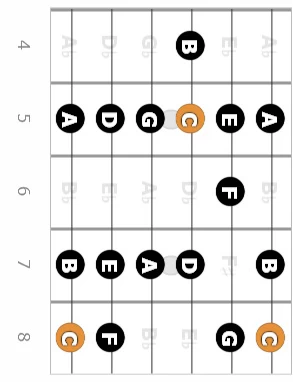
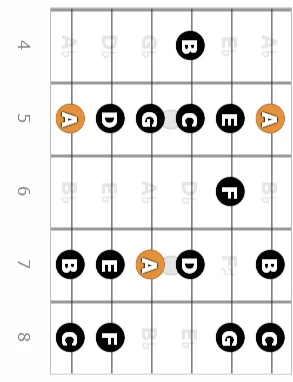
C Major & A Minor: What is the relative minor of C major?
As already shown to you in the example above, A minor is the relative minor of the C major scale as it shares the same notes {A, B, C, D, E, F, G}, which is a collection of all the natural notes in the Western music.
What Are Relative Keys? Learn to Use Relative Key Changes.
A key in music theory refers to the set of notes of a musical scale, with the key being the scale’s root note. The term “A song in the key of C Major” signifies that the sound revolves around the seven notes of the C major scale, including the fundamental notes in the song’s melody, chords, and bass line. Similarly, the music in the minor key revolves around the notes of the corresponding minor scale.
As explained earlier, the relative scales share the same notes and key signatures. These pairs of the root notes of the relative scales are called relative keys. When the same notes are played in a particular order based on the major scale, they sound happy and bright, and when they are played in the relative minor key, they sound sad.
Knowing the relationship between the minor and major scales allows you to memorize many essential things quickly. Instead of the 24 major and minor keys, you must remember 12 thoroughly and quickly figure out the relative keys. The diatonic chords between the two relative scales are the same, making them simpler to memorize.
If you study the pattern of relative scales, it makes things further simpler. To understand this consider an example – the G major scale and E minor are relative. Similarly, Gb major and Eb minor are relative and only a half step below them.
On similar lines, in addition to C major/A minor, Cb major/Ab minor and C# major/A# minor are also relative. These scales are offset by just one semitone.
How to Find the Relative Minor of a Major Key?
The relative minor of any major key can be found using the following methods.
- As highlighted above, the relative minor root of any major key is the sixth note of the major scale.
- You can also use the circle of fifths, as shown in the diagram below. Move by 3 steps or 3 hrs clockwise, considering the twelve positions on the circle of fifths. For example, C major scale is shown at the 12 o’clock position. Move to the 3 o’clock position you get an A, so Am is the relative minor. In the same way, G is at the 1 o’clock position, and E is at the 4 o’clock position, so E is the relative minor of G.
- Notes on the inner circle of fifths are the relative minors.
- You can descend by an interval of a minor third or semitones to get the relative minor. For example, if we reduce three semitones from C {B, A#, A}, we get A, which is its relative minor.
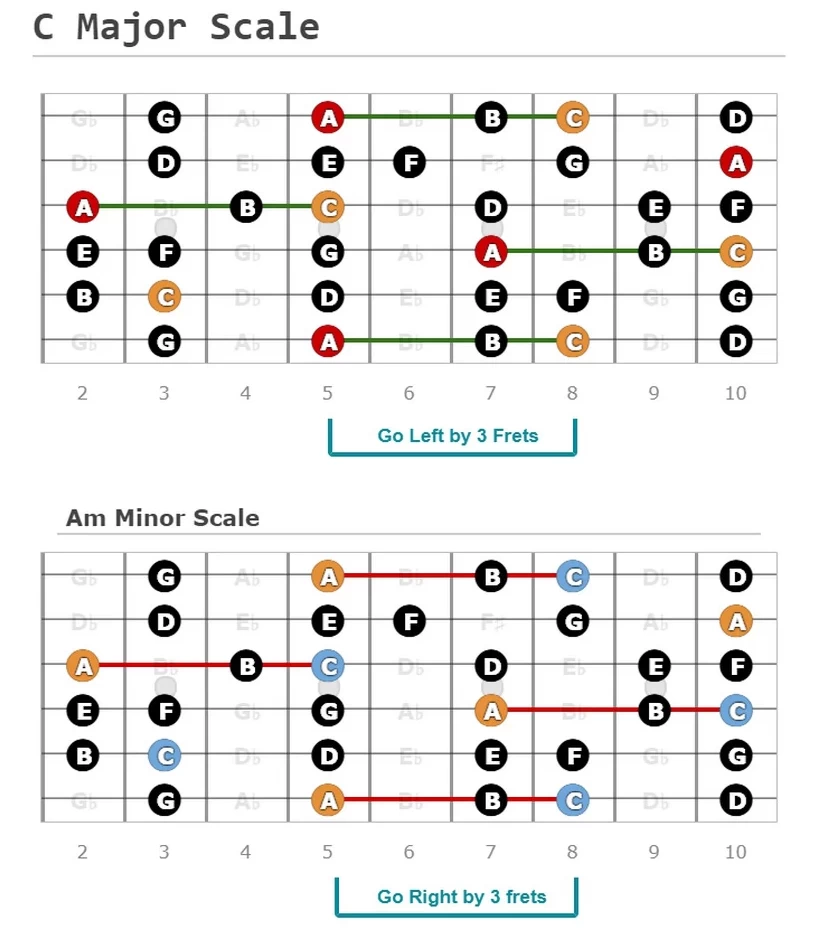
How to Find the Relative Major of a Minor Scale?
As already informed, the two major and minor are relative to each other, as they share the same notes. You also saw that A minor is the relative minor of C major.
- Let us now see the notes of the A minor scale – {A, B, C, D, E, F, G}. We find C is the third note of A minor. So to find the relative majors of any minor scale, we need just to select the third degree of the minor scale.
- In the circle of fifths, go 3 steps, or 3 o’clock counterclockwise.
- Add three semitones or an interval of a minor third. If we add a minor third to A, we get C.
Example of Relative Minor & Major Keys
You can find the relative minor keys of some of the major scales below.
The relative Minor of E Major
The notes of the E major scale as per the scale formula are {E, F#, G#, A, B, C#, D#}. The sixth degree of E major is C#. So, C#min is the relative minor of E major.
Relative Minor of G Major
By the same exercise, we know the notes of the G major scale are {G, A, B, C, D, E, F#}. Hence the sixth-degree note E is the relative minor.
Relative Major of C Minor
You need to 1st find out the notes of the C minor scale, which are {C, D, Eb, F, G, Ab, Bb}. The third-degree note is Eb; hence Eb major is the related major scale for C minor.
The Relative Minor Chord
The relative minor chord is a chord formed from the 6th-degree note of any major scale. Am or Am7 is the relative minor chord in the key of C major.
Relative Major and Minor Pentatonic Scales
You may already know that even the minor pentatonic scale has a relative key to the major pentatonic scale and vice versa. For example, C major pentatonic scale with notes {C, D, E, G, A} is a relative major to the A minor pentatonic scale with notes {A, C, D, E, G}.
As you can see from the above example, the fifth scale degree of any major pentatonic scale is its relative minor, and the 2nd degree of any minor pentatonic scale is its relative major.
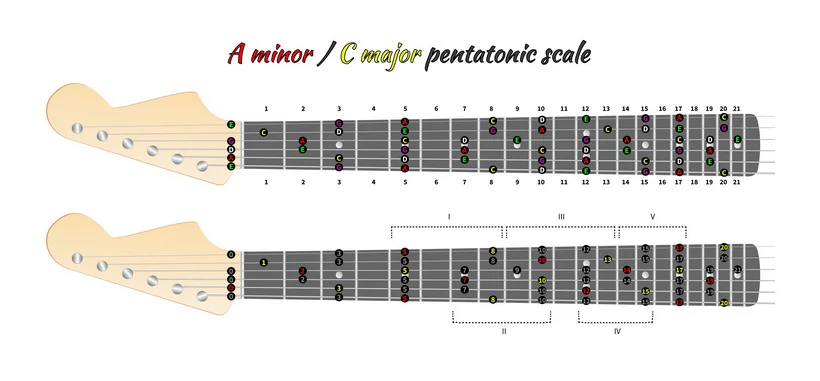
What Is the Difference Between Relative Keys and Parallel Keys?
You have already seen all the details about the relative keys in the article above. Parallel keys between the two scales share the same tonic note, even though the other notes are different. For example, Bb major scale has the Bb minor as its parallel minor scale. You can also say that the B flat major scale has Bb minor as its parallel minor key.
Some musicians feel that shifting between parallel keys provides a more radical shift in the music as new notes are involved while shifting between relative keys is a more subtle experience. The borrowing of chords from the parallel scales is very common also known as the mode mixture. However, both concepts have their own place and utilization in the composition and improvisation of jazz, classical, and popular music.
Relative Keys Chart
The circle of the fifth chart showing the major scales’ relative keys is placed below. The entries in the inner circle show the relative minor scale for the 12 major scales.
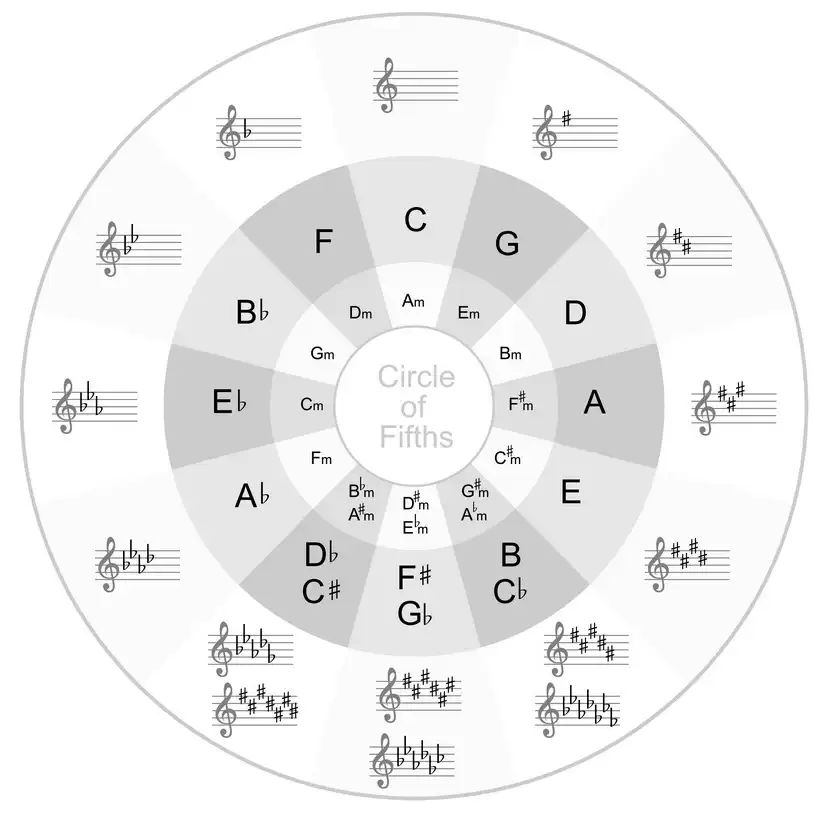
Conclusion
In conclusion, we have looked at the relative scales in music and how they are used to create harmonic movement in a piece of music. We have also seen the relationship between the major and minor keys and their respective scales. I hope this article has been helpful to you. Please let me know in the comments section below if you have any questions or want me to clarify anything.
